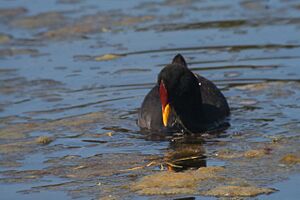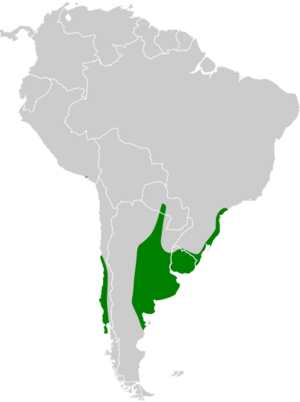Red-fronted coot facts for kids
The red-fronted coot (Fulica rufifrons) is a type of bird that belongs to the group called rails, gallinules, and coots. You can find this bird in several South American countries, including Argentina, Bolivia, Brazil, Chile, Peru, and Uruguay.
Quick facts for kids Red-fronted coot |
|
|---|---|
 |
|
| Conservation status | |
| Scientific classification | |
| Genus: |
Fulica
|
| Species: |
rufifrons
|
 |
|
Contents
What Does the Red-fronted Coot Look Like?
The red-fronted coot is a medium-sized bird, usually about 38 to 43 centimeters (15 to 17 inches) long. Male birds can weigh around 685 to 735 grams (24 to 26 ounces), while females are a bit lighter, weighing about 550 grams (19 ounces). Both male and female red-fronted coots look very similar.
Adult coots have a bright yellow beak and a dark, reddish-brown patch on their forehead, called a frontal shield. Their legs and feet are olive green. What makes them special among coots is that their feet are not lobed, meaning they don't have those flat, paddle-like flaps that other coots have. Their feathers are mostly dark gray, but they have white feathers under their tail.
Young red-fronted coots have a blackish beak and some white spots on their throat. Their body feathers are gray-brown, and they also have the same white feathers under their tail as the adults.
Where Do Red-fronted Coots Live?
Red-fronted coots live along the coast from southern Peru down to central Chile. They are also found in parts of Bolivia, and from southeastern Brazil south through Uruguay to east-central Argentina. Sometimes, they might wander to places like Paraguay or the Falkland Islands, but these visits are rare.
These coots usually live in low-lying areas, from sea level up to about 800 meters (2,600 feet) high. However, they can sometimes be seen much higher, even up to 2,100 meters (6,900 feet) in Argentina, and regularly at 3,700 meters (12,100 feet) at Alalay Lake in Bolivia.
They prefer shallow, semi-open marshes and lakes that have lots of reeds and floating plants, like duckweed. These plants provide good cover and food for them.
How Do Red-fronted Coots Behave?
Moving Around
Scientists haven't found any regular long-distance movements for the red-fronted coot. However, when they are seen in places far from their usual homes, it suggests that some birds do travel or spread out. In the northern parts of Brazil, they seem to only stay there during the winter months.
What Do Red-fronted Coots Eat?
Red-fronted coots mostly eat by pecking at plants on the surface of the water. They also dive underwater to find food. When their usual marshy homes dry up during certain seasons, they might graze on plants near the water. They often feed in small groups, sometimes even joining other coots like the red-gartered coot.
Red-fronted Coot Reproduction and Life Cycle
Red-fronted coots are monogamous, meaning one male and one female stay together to raise their young. The time they lay eggs changes depending on where they live. In Chile, they lay eggs in September and October. In Argentina, it's from May to November, and in Peru, it's from September to January.
They build their nests from plant materials, placing them low in the water among floating or standing plants. A female coot usually lays about five to six eggs, but sometimes it can be as few as two or as many as nine. The black-headed duck is a bird that sometimes lays its eggs in the red-fronted coot's nest, making the coot raise its chicks!
Red-fronted Coot Sounds
The red-fronted coot makes a "long, chattering" sound that can be described as "togo togo togo..." or "cu cu cu..." or "puhúh puhúh puhúh...". They also have a short "tuc" call that they use when they sense danger.
How Are Red-fronted Coots Doing?
The IUCN (International Union for Conservation of Nature) says that the red-fronted coot is a species of "Least Concern." This means they are not currently in danger of disappearing. They live across a large area, and even though we don't know their exact population size, it seems to be stable. There are no big threats to them right now. They are considered "not uncommon" in many places they live and are even very common in the marshes of the Pampas region.


